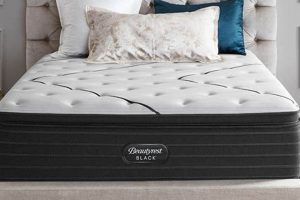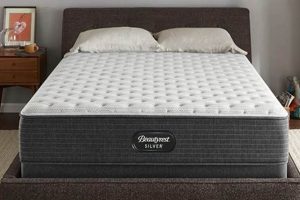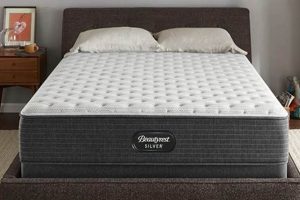The dimensional disparity between these two common mattress sizes constitutes a significant factor for consumers when furnishing a bedroom. One provides greater width, while the other offers a more compact sleeping surface. The choice depends largely on individual preferences, room size, and sleeping arrangements. For example, individuals sharing a bed may find the larger surface area more conducive to undisturbed rest.
Understanding the distinction is important due to its impact on sleep quality, bedroom aesthetics, and associated costs. A larger sleeping surface can improve sleep quality by reducing partner disturbance. Selecting the appropriate size ensures optimal room proportions and facilitates furniture placement. Furthermore, bedding, frames, and other accessories are size-specific, impacting overall expenditure. Historically, mattress sizes evolved to accommodate changing living spaces and evolving standards of personal comfort.
The subsequent sections will delve into specific measurements, ideal room sizes, and key considerations for selecting the optimal mattress for individual needs. This analysis will also examine price points, bedding availability, and other factors relevant to informed consumer decision-making.
Considerations for King Versus Queen Mattress Selection
Selecting the appropriate mattress size requires careful evaluation of several factors. These tips provide guidance for navigating the decision between king and queen options based on objective criteria.
Tip 1: Room Dimensions: Assess the bedroom’s square footage. A king mattress is better suited for larger rooms, generally exceeding 12 feet by 12 feet, to maintain spatial balance and ease of movement. A queen mattress works well in smaller spaces, typically starting at 10 feet by 10 feet.
Tip 2: Sleep Partner Preferences: Evaluate sleeping habits. If restless sleep patterns or significant size differences exist between sleep partners, the increased width of a king mattress can minimize disturbance and improve individual sleep quality.
Tip 3: Budgetary Constraints: Analyze budgetary limitations. King mattresses, bedding, and frames generally incur higher costs compared to queen-sized alternatives. This difference should be considered when allocating resources.
Tip 4: Bedding Availability: Check the availability of bedding. While both sizes offer ample options, specialized or unique bedding styles might be more readily available for one size over the other. Confirm desired styles are available for the preferred size.
Tip 5: Long-Term Needs: Project future needs. Consider potential life changes, such as expanding family size or relocating to a larger residence. A larger mattress can offer more versatility over time.
Tip 6: Physical Limitations: Determine physical space to be used for the mattress size. The sizes offered by mattress brands are mostly standardized but there can be a size different from the general standard.
By carefully considering these tips, an informed decision can be made to maximize sleep quality, optimize room aesthetics, and manage budgetary resources effectively. Selecting the right mattress is a crucial step towards creating a comfortable and functional sleep environment.
The subsequent section will provide an in-depth analysis of material composition and mattress types, further enabling informed purchasing decisions.
1. Surface Area
Surface area represents a primary differentiating factor between king and queen mattresses. The larger surface area of a king mattress offers greater individual sleeping space, affecting comfort, partner disturbance, and overall sleep quality. Its understanding is vital for choosing the optimal size based on individual needs and bedroom dimensions.
- Individual Sleeping Space
The increased surface area directly translates to more personal space for each sleeper. This is especially important for individuals who move frequently during sleep, prefer to spread out, or have larger body sizes. Insufficient individual space can lead to restless nights and compromised sleep quality.
- Partner Disturbance Mitigation
Greater surface area reduces the likelihood of sleep disruption caused by a partner’s movements. The increased distance between sleepers minimizes the impact of tossing, turning, or getting in and out of bed. This can be particularly beneficial for light sleepers or individuals with differing sleep schedules.
- Temperature Regulation
The expanse of a king mattress allows for more effective heat dissipation compared to a smaller queen. This is because individuals are less likely to be in direct contact, minimizing heat transfer. This can contribute to a cooler and more comfortable sleep environment, especially for individuals who tend to sleep hot.
- Perceived Luxury and Comfort
The sheer size of a king mattress often contributes to a perception of greater luxury and comfort. The expansive sleeping surface can enhance the overall sleep experience, contributing to a sense of spaciousness and relaxation. This psychological aspect, though subjective, can be a significant factor for some consumers.
In conclusion, the surface area of a mattress directly impacts factors ranging from individual comfort and sleep quality to partner disturbance and temperature regulation. These considerations are critical in the king versus queen size deliberation, informing a decision that optimally addresses individual and shared sleep needs, ultimately ensuring a restful and rejuvenating sleep experience.
2. Room Size
Room size exerts a considerable influence on the suitability of mattress dimensions, serving as a critical determinant in the selection between king and queen options. Optimal bedroom design considers both functionality and aesthetics, factors significantly impacted by mattress size relative to available space. The compatibility between room size and mattress dimensions contributes directly to the overall ambiance and usability of the sleeping environment.
- Spatial Balance and Movement
Sufficient space surrounding the mattress is essential for comfortable movement and unimpeded access to other bedroom furniture. A king mattress in a small room can obstruct walkways and create a cramped feeling, impacting functionality. Conversely, a queen mattress in an expansive room may appear disproportionately small, diminishing the room’s visual appeal. The goal is to achieve a harmonious balance between mattress size and room dimensions to ensure ease of navigation and a sense of spaciousness. For example, placing a king bed in a 10×10 room would leave little space for walking or additional furniture.
- Furniture Placement and Accessibility
Room size dictates the feasibility of incorporating essential bedroom furniture such as nightstands, dressers, and seating areas. A larger mattress necessitates reduced furniture sizes or fewer pieces to avoid overcrowding. The chosen mattress should allow for convenient access to furniture, ensuring functionality and preventing an obstructed flow. In situations where the room is small, prioritizing a queen mattress might be a better choice to allow for the addition of other essential furniture.
- Visual Aesthetics and Proportionality
The relationship between mattress size and room dimensions affects the room’s visual aesthetics and proportional balance. A king mattress can serve as a focal point in a larger bedroom, lending a sense of grandeur and luxury. In contrast, a queen mattress may be more visually appropriate in a smaller room, maintaining a sense of scale and preventing the room from appearing overwhelmed. Choosing the correct mattress size ensures that the room is visually appealing and creates a sense of comfort.
- Impact on Overall Room Functionality
Ultimately, the choice between king and queen mattresses based on room size directly impacts the overall functionality of the bedroom. The objective is to optimize both sleeping space and living space, creating a comfortable and practical environment. An informed decision enhances the bedroom’s usability, ensuring it serves as a restful sanctuary without sacrificing functionality. A well-balanced ratio of mattress size to room size is crucial for achieving a functional and aesthetically pleasing space.
These facets underscore the importance of aligning mattress dimensions with room size. This process will lead to creating not only a visually appealing but also fully functional sleeping environment. A comprehensive understanding of the relationship between room size and mattress dimensions ensures that the chosen option aligns with the bedroom’s spatial constraints, furniture requirements, and desired aesthetic, leading to an enhanced user experience.
3. Cost Disparity
The economic differential represents a significant component of the disparity between king and queen mattresses. This divergence in pricing permeates not only the initial purchase of the mattress itself but also extends to associated expenses, including bedding, frames, and potentially even delivery charges. The underlying causes stem from the greater material requirements inherent in producing a larger mattress, increased manufacturing complexity, and subsequently, higher transportation costs. For instance, a memory foam king mattress from a prominent brand may retail for $1200, whereas a comparable queen mattress from the same line may be priced at $900. The resulting $300 difference underscores the material cost effect, making the king a substantially larger investment.
This economic impact extends beyond the mattress itself. Specialized king-sized bedding, such as sheets, comforters, and duvets, invariably command a premium compared to their queen-sized counterparts. Similarly, king-sized bed frames, designed to provide adequate support for the larger mattress, typically incur higher costs due to increased material usage and structural reinforcement. Real-world examples are ubiquitous. A high-thread-count Egyptian cotton sheet set might cost $250 for a king size and $180 for a queen. These incremental costs accumulate, amplifying the overall financial commitment associated with selecting a king-sized sleep system. Practical significance lies in recognizing that the initial mattress price represents only a fraction of the total investment required for a complete and functional bedroom setup.
In conclusion, the cost disparity between king and queen mattresses is a multifaceted issue, stemming from material costs, manufacturing complexity, and secondary expenses related to bedding and frames. This economic aspect constitutes a crucial consideration in the decision-making process, particularly for budget-conscious consumers. A thorough evaluation of both the immediate purchase price and the long-term implications of associated expenses is essential for making an informed and fiscally responsible choice, while optimizing both sleep quality and overall bedroom functionality.
4. Partner Disturbance
Partner disturbance, stemming from nocturnal movements, variations in sleep schedules, or disparate sleep preferences, constitutes a pivotal factor in the differentiation between king and queen mattress sizes. The primary effect of partner disturbance is compromised sleep quality for one or both individuals sharing the bed. A smaller sleeping surface intensifies the impact of these disturbances, while a larger surface area can mitigate their effects. For instance, individuals with restless partners often report improved sleep when transitioning from a queen to a king mattress, owing to the increased spatial separation.
The significance of partner disturbance as a component of the dimensional contrast lies in its direct correlation with sleep quality and overall well-being. The increased width of a king mattress, typically 16 inches wider than a queen, provides each sleeper with more personal space, thus reducing the likelihood of physical contact and minimizing the transmission of movement. Consider a scenario where one partner frequently gets out of bed during the night. On a queen mattress, this movement can readily disturb the other partner. However, on a king, the greater distance can significantly reduce this disturbance. This aspect is particularly relevant for individuals with diagnosed sleep disorders or those sensitive to external stimuli during sleep.
In summary, the connection between partner disturbance and the difference between king and queen mattress sizes is fundamental. Recognizing the impact of nocturnal movements and sleep variations on sleep quality highlights the practical importance of selecting the appropriate mattress size. While a queen mattress may suffice for single sleepers or couples with synchronized sleep patterns, a king mattress often provides a more conducive sleep environment for those experiencing partner disturbance. Addressing this issue effectively can lead to improved sleep, enhanced well-being, and a more harmonious co-sleeping experience.
5. Bedding Availability
The correlation between bedding availability and mattress size constitutes a noteworthy factor in the king versus queen mattress selection process. This facet focuses on the ease with which appropriately sized sheets, comforters, duvet covers, and other bedding items can be procured. Discrepancies in bedding availability can influence consumer decisions, particularly when specific styles, materials, or price points are sought. Typically, queen-sized bedding enjoys broader accessibility compared to king-sized options, owing to higher demand and standardization. For instance, a consumer seeking a specific brand of organic cotton sheets may find limited availability in king sizes, whereas queen sizes are readily stocked.
The influence of bedding availability extends beyond mere selection. It can also impact cost and convenience. Limited availability often translates to higher prices for king-sized be
dding, as retailers may apply a premium due to reduced supply and increased shipping costs. Moreover, specialized bedding configurations, such as split-king adjustable bed sets, may present even greater challenges in terms of accessibility and pricing. Conversely, queen-sized bedding frequently benefits from competitive pricing and widespread availability, making it a more accessible and budget-friendly option for many consumers. For example, finding a discounted queen-size comforter set is generally easier than locating a comparable discount on a king-size set. The practical significance lies in recognizing that bedding represents a recurring expense throughout the mattress’s lifespan. Therefore, ease of acquisition and affordability should be carefully considered.
In summary, bedding availability serves as a crucial, yet often overlooked, component in the differentiation between king and queen mattresses. The broader selection, increased affordability, and enhanced convenience associated with queen-sized bedding can significantly influence consumer choices, particularly for those prioritizing practicality and budgetary constraints. While king-sized bedding offers its own advantages in terms of size and luxury, potential limitations in availability and increased costs should be carefully weighed against individual needs and preferences, ensuring a harmonious balance between comfort, aesthetics, and long-term affordability.
6. Weight Distribution
Weight distribution, defined as the dispersion of mass across a surface, plays a pivotal role in discerning functional distinctions between king and queen mattresses. Even weight distribution directly influences mattress longevity, support characteristics, and overall sleep comfort. Uneven weight distribution can accelerate mattress degradation, compromise spinal alignment, and exacerbate partner disturbance. Therefore, understanding weight distribution is critical in evaluating the suitability of either mattress size.
- Individual Weight Capacity and Support
Each mattress size possesses a specific capacity for supporting weight while maintaining structural integrity. Exceeding this capacity can lead to sagging, loss of support, and premature wear. The larger surface area of a king mattress generally provides a higher overall weight capacity, accommodating individuals or couples with greater combined weight. This is important to maintain the integrity and lifespan of the mattress. For example, a couple with a combined weight of 400 pounds might experience better support and longevity from a king mattress compared to a queen mattress with a lower weight rating. The implications extend to ensuring proper spinal alignment and preventing pressure points, thereby enhancing sleep quality.
- Localized Pressure and Sagging
Concentrated weight in specific areas can cause localized pressure and sagging over time. The distribution of weight across a mattress influences its resistance to these localized deformations. King mattresses, with their larger surface area, tend to distribute weight more evenly, reducing the risk of localized sagging. This is particularly relevant for individuals who consistently sleep in the same position or spend extended periods sitting on the edge of the bed. A queen mattress may exhibit sagging more rapidly under similar conditions, potentially leading to discomfort and compromised support. This can be prevented by selecting the mattress with proper weight management.
- Motion Isolation and Partner Disturbance
Weight distribution affects the degree of motion transfer across the mattress surface. Effective weight distribution minimizes the transmission of movement from one sleeper to another, reducing partner disturbance. King mattresses, due to their greater width and ability to distribute weight over a larger area, generally offer superior motion isolation compared to queen mattresses. This is a significant advantage for couples with differing sleep schedules or restless partners. The reduction in motion transfer promotes uninterrupted sleep and enhances overall sleep satisfaction.
- Edge Support and Usable Surface Area
Edge support, defined as the stability and resistance to compression along the mattress perimeter, is directly influenced by weight distribution. Strong edge support maximizes the usable surface area of the mattress and facilitates getting in and out of bed. A king mattress with reinforced edges provides a more stable and supportive perimeter compared to a queen mattress. This is particularly beneficial for individuals who frequently sit on the edge of the bed or prefer to sleep close to the edge. Adequate edge support enhances comfort, safety, and the overall usable sleeping surface.
In summary, weight distribution constitutes a critical aspect of differentiating between king and queen mattresses, influencing support characteristics, longevity, motion isolation, and edge support. The enhanced weight distribution capabilities of king mattresses, stemming from their larger surface area, generally offer superior performance in these areas. However, individual needs, weight considerations, and sleep preferences should be carefully evaluated to determine the optimal mattress size for maximizing sleep quality and overall satisfaction.
7. Frame Options
The availability and suitability of bed frame options represent a crucial differentiating factor when considering the variations in king and queen mattress dimensions. Frame selection impacts not only the aesthetic presentation of the bed but also its structural support, height, and compatibility with headboards and footboards. Consequently, the range of available frame designs and materials may influence a consumer’s ultimate choice between mattress sizes.
- Standard Frame Availability and Cost
Queen-sized bed frames, owing to their widespread popularity, generally offer a broader selection and tend to be more competitively priced than king-sized frames. Retailers typically stock a greater variety of queen frames in diverse styles, materials (metal, wood, upholstered), and price ranges. This wider availability translates to increased consumer choice and potentially lower costs. For instance, a simple metal platform frame might cost $100 for a queen size but $150 for a king, reflecting material cost differences. The practical implication is that consumers with budget constraints or specific design preferences may find queen frames more readily accessible and affordable.
- Specialty Frame Designs
Certain frame designs, such as adjustable bed frames or platform beds with built-in storage, may exhibit variations in availability between king and queen sizes. Split-king adjustable bed frames, designed for use with two separate twin XL mattresses to accommodate individual sleep preferences, represent a specialized category with limited availability compared to queen-sized adjustable frames. Similarly, platform beds with integrated drawers or shelving may offer different storage capacities or configurations depending on the mattress size. This disparity underscores the need for consumers to carefully evaluate the availability of their desired frame features and functionalities when selecting a mattress size.
- Headboard and Footboard Compatibility
The compatibility of headboards and footboards with different mattress sizes
and frame types constitutes another relevant consideration. While many standard headboards are designed to be universally compatible with both king and queen frames (often through adjustable mounting brackets), certain designs, particularly antique or custom-made pieces, may be specifically sized for one mattress dimension or the other. Consumers who already possess a cherished headboard or footboard should verify its compatibility with their intended mattress size before making a purchase. This avoids the need for costly modifications or the selection of an alternative frame. - Structural Support and Weight Capacity
Bed frames must provide adequate structural support to ensure mattress longevity and user safety. King-sized mattresses, due to their larger surface area and potential for increased weight load, often require frames with enhanced support features, such as center support legs or reinforced side rails. Failure to provide adequate support can lead to mattress sagging, frame instability, and potential safety hazards. Consumers should carefully assess the weight capacity and structural integrity of any frame under consideration, particularly when selecting a king-sized mattress, to ensure long-term durability and safe use.
These aspects of frame options highlight the nuanced interplay between mattress size and support structure selection. An informed decision requires careful consideration of budget, design preferences, feature requirements, compatibility concerns, and structural support needs. Thoroughly evaluating frame options in conjunction with mattress size considerations ensures a cohesive and functional bedroom ensemble that optimizes both comfort and aesthetics.
Frequently Asked Questions
The following section addresses common inquiries regarding the dimensional and functional distinctions between king and queen mattresses, providing objective information to assist in informed decision-making.
Question 1: Is a king mattress simply a larger version of a queen mattress, or are there fundamental design differences?
While both mattress types share similar construction principles, a king mattress is not merely an enlarged queen. The increased width necessitates adjustments in internal support structures and material distribution to ensure uniform comfort and prevent sagging. The internal coil system, foam layering, and edge support systems are all specifically engineered to accommodate the larger surface area and potential weight load.
Question 2: What is the minimum recommended room size for comfortably accommodating a king-sized mattress?
The minimum recommended room size for a king mattress is generally considered to be 12 feet by 12 feet. This allows for adequate space around the bed for movement, furniture placement, and a balanced visual aesthetic. Smaller rooms may feel cramped and restrict functionality with a king mattress.
Question 3: Are bedding costs significantly higher for king-sized mattresses compared to queen-sized mattresses?
Yes, bedding costs are typically higher for king-sized mattresses. The increased material requirements for sheets, comforters, and duvet covers translate to higher retail prices. This cost differential should be factored into the overall budget when selecting a mattress size.
Question 4: Does a king mattress inherently offer better motion isolation than a queen mattress?
While a larger surface area contributes to improved motion isolation, the material composition and construction of the mattress itself are more critical factors. A king mattress made with high-density foam or individually pocketed coils will generally provide superior motion isolation compared to a queen mattress with a less sophisticated design. However, size alone does not guarantee better motion isolation.
Question 5: How does mattress size affect the longevity and durability of the product?
Mattress size indirectly impacts longevity through its influence on weight distribution and structural support. A larger mattress, properly supported by a suitable frame, can distribute weight more evenly, reducing the risk of localized sagging and premature wear. However, the quality of materials and construction techniques are the primary determinants of mattress durability.
Question 6: Is it possible to use two twin XL mattresses on a king-sized bed frame?
Yes, two twin XL mattresses are specifically designed to fit a standard king-sized bed frame. This configuration is often used with adjustable bed frames to allow for individualized sleep positions and preferences on each side of the bed.
In summary, the choice between a king and queen mattress involves careful consideration of room size, budgetary constraints, sleeping habits, and individual preferences. Understanding the nuances of each size empowers consumers to make informed decisions that optimize sleep quality and overall satisfaction.
The subsequent section will discuss the impact of mattress materials on the overall sleep experience.
Difference Between King and Queen Mattress
The foregoing analysis delineates the significant distinctions between king and queen mattress dimensions and their implications. Surface area, room size compatibility, cost variations, motion isolation characteristics, bedding availability, and weight distribution capabilities constitute key factors in determining the optimal choice. A comprehensive understanding of these variables enables a more informed purchasing decision, aligning selection with individual needs and spatial constraints.
The decision regarding mattress size represents a critical investment in sleep quality and overall well-being. Continued research into mattress materials, support systems, and ergonomic design will further refine the selection process. Careful consideration of the data presented herein is paramount in securing a sleep environment conducive to optimal rest and long-term physical health.







